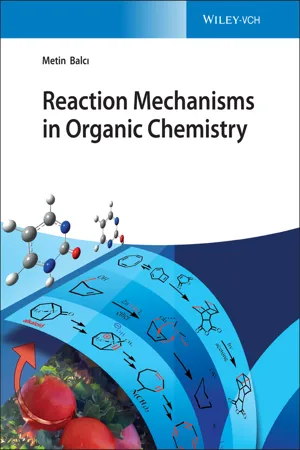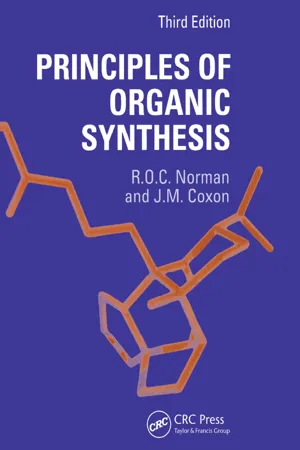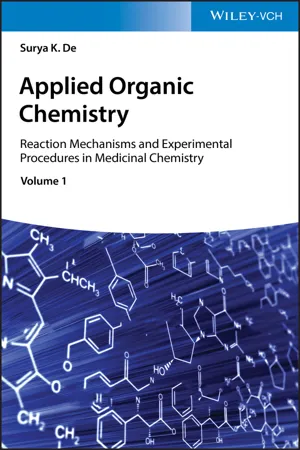Chemistry
Claisen Condensation
The Claisen condensation is a chemical reaction that involves the formation of a carbon-carbon bond between two esters or one ester and another carbonyl compound. This reaction is catalyzed by a base and results in the formation of a β-keto ester or a β-diketone. The Claisen condensation is an important tool in organic synthesis for the formation of complex molecules.
Written by Perlego with AI-assistance
Related key terms
Related key terms
1 of 4
Related key terms
1 of 3
4 Key excerpts on "Claisen Condensation"
- eBook - ePub
- Metin Balc?, Metin Balc?, Metin Balc?, Metin Balc?, Metin Balc?(Authors)
- 2021(Publication Date)
- Wiley-VCH(Publisher)
The crossed Claisen ester condensation can also be carried out with strong and sterically hindered bases such as LDA. One of the esters can be selectively reacted with LDA, which will abstract the α-proton irreversibly to form an enolate. Then, this enolate can be reacted with another ester as shown below.Another variation of the Claisen Condensation is the reaction of esters with ketones. The reaction proceeds well when the ester does not have any hydrogen atoms at the α-position. For example, a reaction of 2,2,-dimethylcyclohexanone with ethyl formate gives a β-ketoaldehyde in high yield.5.7.6 Dieckmann Condensation
The Dieckmann condensation is a variation of the Claisen Condensation. The Claisen ester condensation takes place intermolecularly between two ester groups. If the ester groups are on the same molecule, an intramolecular reaction occurs between the ester groups in the presence of a base to furnish a cyclic β-ketoester. This reaction is called the Dieckmann reaction and is named after the German chemist Walter Dieckmann (1869–1925). The reaction has been successfully applied to the synthesis of five- and six-membered compounds. For this, 1,6- and 1,7-diesters are ideal starting compounds.The mechanism of the Dieckmann condensation is the same as that of the Claisen Condensation. First, the base removes one proton from the α-carbon atom next to the ester group, forming an enolate, which adds to the carbonyl group of the other ester group, forming a cyclic tetrahedral intermediate. During the carbonyl group's reformation, the electrons on the oxygen atom displace the ethoxy group to produce a β-ketoester. Since the protons attached to C2 and C6 carbon atoms in this system are identical, the result does not change which proton is removed.Starting with a 1,6-diester, five-membered ring, β-ketoesters can be easily synthesized [99] - eBook - ePub
- Richard O.C. Norman(Author)
- 2017(Publication Date)
- Routledge(Publisher)
The self-condensation of an ester which contains an α-hydrogen atom is known as the Claisen (ester) condensation. The simplest example is the formation of acetoacetic ester (ethyl 3-oxobutanoate) from ethyl acetate, catalyzed by ethoxide ion:The reaction is usually carried out by refluxing very dry ethyl acetate over sodium wire. The sodium reacts with the 2–3% of ethanol which is present in commercial ethyl acetate, generating ethoxide ion which then catalyzes the reaction. The product is obtained as the sodium salt of acetoacetic ester from which the free ester is liberated by treatment with acetic acid. Yields of about 30% are obtained [1].The Claisen Condensation differs from the aldol reaction only after the oxyanion has been formed by addition of the enolate to the carbonyl group: in the Claisen reaction this anion eliminates ethoxide ion to give a β-keto-ester, whereas in the aldol reaction the anion gains a proton to give a β-hydroxy-aldehyde or ketone.Each step in the Claisen Condensation is reversible, and acetoacetic ester can be isolated in significant yield only because it is essentially completely removed from equilibrium by conversion into its anion under the influence of ethoxide ion (i.e. acetoacetic ester is a much stronger acid than ethanol). However, in those cases in which the β-keto-ester product does not contain a C—H bond adjacent to both keto and ester groups so that this marked acidic character is absent, the equilibria are unfavourable to reaction when ethoxide ion is the base. For example, ethyl isobutyrate, Me2 CHCO2 Et, fails to give Me2 CH—CO—CMe2 —CO2 Et in these conditions. This problem can be surmounted by using a very much stronger base than ethoxide ion, and the triphenylmethide ion, added as sodium triphenylmethyl, is conveniently employed. This results in the essentially complete removal of the ethanol formed in the reaction:(i) Mixed reactions - eBook - ePub
Applied Organic Chemistry
Reaction Mechanisms and Experimental Procedures in Medicinal Chemistry
- Surya K. De(Author)
- 2020(Publication Date)
- Wiley-VCH(Publisher)
2 Condensation ReactionA condensation reaction is a broad class of organic addition reactions in which two or more identical or different molecules combine together typically proceed in a through stepwise fashion to form a single addition product with elimination of water (hence named condensation). Instead of water, the reaction can proceed with elimination of simple units like ammonia, ethanol, or acetic acid. The condensation reaction can occur in acidic, basic conditions or in the presence of other catalysts. This type of reactions is an essential part of our life as it is an important to form peptide bonds in between amino acids in protein and the biosynthesis of fatty acids.Condensation of two amino acids gives a peptide and water. Here we describe some named condensation reactions and more condensation reactions can be found in other chapters as well.Aldol Condensation Reaction
Ketones with hydrogen on the carbon atom adjacent to the carbonyl group are called as α‐hydrogen, and it is very reactive in the presence of base or acid. On treatment with base benzaldehyde and acetophenone undergo a carbon–carbon bond‐forming reaction called the aldol condensation [1 - Paulo Costa, Ronaldo Pilli, Sergio Pinheiro, Peter Bakuzis(Authors)
- 2022(Publication Date)
- Royal Society of Chemistry(Publisher)
Scheme 8.2 shows the accepted mechanism for the Claisen Condensation employing ethyl acetate. The initial steps (formation of the enolate ion and its nucleophilic addition to the ester carbonyl) resemble those proposed for the aldol condensation reaction discussed in Section 4.2 for aldehydes and ketones.Scheme 8.2 The mechanism of the Claisen Condensation.Addition of the sodium enolate derived from ethyl acetate (present in low concentration) to ethyl acetate (major form in the equilibrium) leads to the formation of a tetrahedral intermediate via nucleophilic addition, which is then converted to ethyl acetoacetate by the loss of the ethoxy group (elimination step).These steps are reversible, but in the presence of sodium ethoxide, ethyl acetoacetate (pK a 11, in H2 O and 14, in DMSO) is almost irreversibly transformed to the corresponding enolate, which is resonance stabilized by the two carbonyl groups driving the equilibrium towards the condensation product. Additionally, as the reaction is generally carried out under heating, the ethanol formed may be removed by distillation to favor product formation. During the isolation step, acidification of the reaction medium allows the isolation of ethyl acetoacetate.When planning Claisen Condensations, it is important to use as base an alkoxide corresponding to the alcohol residue present in the starting ester to avoid a transesterification reaction (Section 7.1.2) which would result in a mixture of β-ketoesters. As the last step is irreversible and depends on the base, one equivalent of the base must be used in order to maximize yields.Exercise
Explain the formation of methyl acetoacetate when the reaction shown in Scheme 8.2 is performed with MeONa, in MeOH.Exercise
Write a mechanism to explain why esters containing a single Hα do not undergo the Claisen Condensation under the conditions described in Scheme 8.2.The crossed Claisen Condensation involves the reaction of two different esters, but high yields are usually limited to the cases where only one has an acidic Hα. In such cases, the enolizable ester is added slowly to a solution of the non-enolizable ester and the base, in order to ensure excess of the latter during the reaction and minimize the formation of Claisen self-condensation products (Scheme 8.3).
Index pages curate the most relevant extracts from our library of academic textbooks. They’ve been created using an in-house natural language model (NLM), each adding context and meaning to key research topics.
Explore more topic indexes
Explore more topic indexes
1 of 6
Explore more topic indexes
1 of 4



